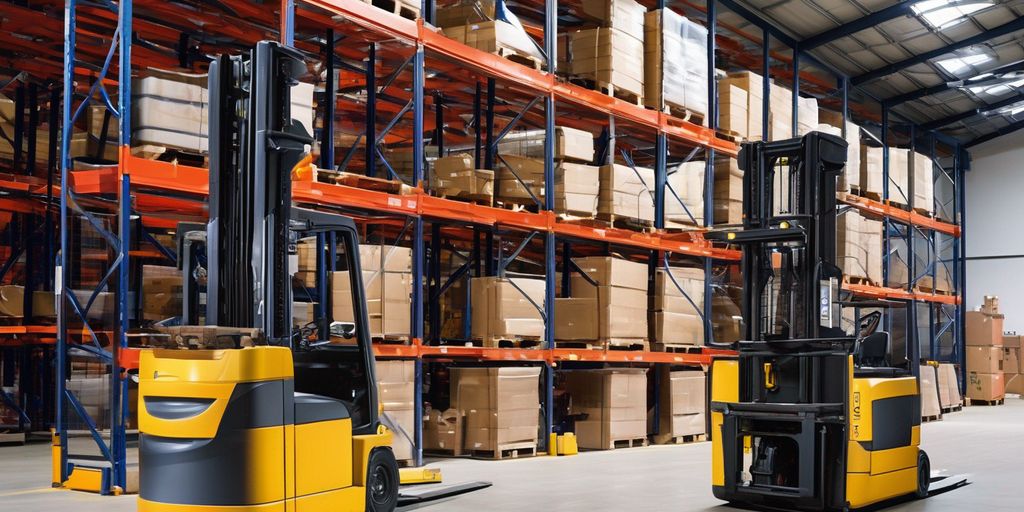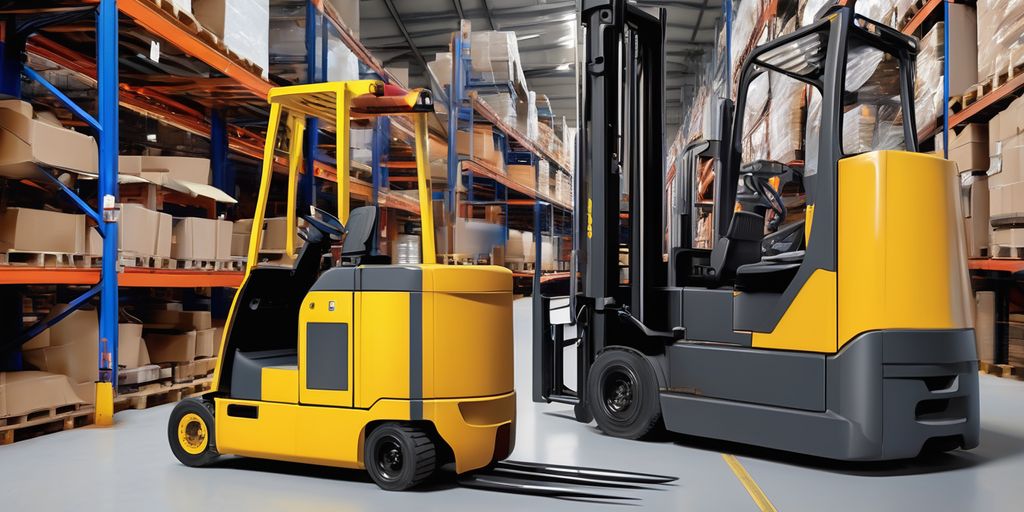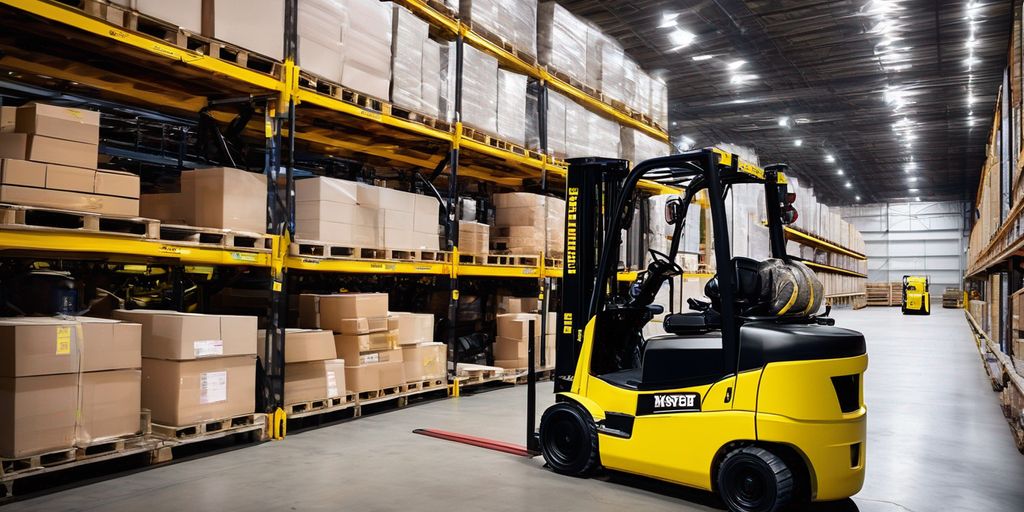Forklift trucks are indispensable machines in various industries, from warehousing to construction. Understanding the essential parts of a forklift truck is crucial for operators, supervisors, and business owners alike. This guide breaks down the main components of a forklift, explaining their functions and importance in ensuring safe and efficient operation.
Key Takeaways
- The truck frame is the foundational structure that provides stability and houses essential components like fuel and hydraulic fluid tanks.
- The mast is responsible for the vertical movement of loads, enabling the forklift to raise and lower heavy items efficiently.
- Forks are the prongs attached to the mast that slide under loads to lift and carry them, making them essential for the forklift's lifting function.
- The counterweight, located at the rear of the forklift, balances the load being lifted to prevent tipping and ensure safe operation.
- The power source, which can be an internal combustion engine or an electric motor, drives the forklift and powers its various functions.
The Truck Frame: Foundation of Stability
The truck frame of a forklift is akin to the chassis of a car. It is the metal frame to which many of the major forklift components are attached, including the wheels, axles, engine, mast, counterweight, and overhead guard. It provides the core stability needed to lift heavy loads. In some forklifts, tanks for fuel or hydraulic fluids are built into the truck frame.
The Mast: Backbone of Vertical Movement
The forklift mast is the raised vertical support that allows loads to be raised and lowered. For most forklifts, the mast is designed toward the front of a forklift and directly in the forklift operator’s line of vision.
Raising and Lowering Loads
The lift cylinder powers the vertical movement of the mast, allowing the carriage and forks to move up and down. This is what gives the forklift the power to lift loads.
Types of Masts
Forklift masts come with various sections that elevate or lower the forklift carriage along with the forks. These include:
- Duplex: Two mast stages
- Triplex: Three mast stages
- Quad: Four mast sections
Maintenance Tips
Regular maintenance of the mast is crucial for the safe and efficient operation of a forklift. This includes checking the hydraulic cylinders, inspecting the interlocking rails, and ensuring that all moving parts are well-lubricated.
Proper maintenance of the mast can prevent costly repairs and ensure the safety of the operator and the workplace.
The Forks: Essential Lifting Prongs

The forks are arguably the most important component on a forklift. They are what allow the forklift to lift and move heavy loads. The forks slide under the load and then lift it up so it can be transported.
The Counterweight: Balancing the Load
The counterweight is a weight on the back end of the forklift installed into the truck frame. Its purpose is to counterbalance the weight of the load lifted or carried by the forklift to keep it stable and prevent tipping. The counterweight is designed only to counterbalance the intended maximum carrying capacity. It is important for forklift operators to know the maximum carrying capacity to prevent serious accidents.
The Power Source: Driving Force Behind the Forklift
The power source is the heart of your forklift, providing the energy to get the job done. Most forklifts run on electric motors, internal combustion engines, or a combination of the two.
The Tilt Cylinders: Ensuring Load Stability
Hydraulic Mechanism
Tilt cylinders are double-acting hydraulic cylinders that control the forward and backward movement of the mast. They are crucial for adjusting the angle of the forks relative to the ground, ensuring that loads are stable during transport. This mechanism allows the mast to tilt both forwards and backwards, providing flexibility and control.
Functionality and Operation
The tilt cylinder's primary function is to control the tilt of the carriage and the angle of the forks. This is essential for maintaining load stability, especially when navigating uneven surfaces or making turns. Proper operation involves smooth and controlled movements to avoid tip-over accidents.
Maintenance and Safety
Regular maintenance of tilt cylinders is vital for safe forklift operation. This includes checking for hydraulic fluid leaks, inspecting the cylinder for wear and tear, and ensuring that all connections are secure. Routine checkups can prevent malfunctions and enhance the longevity of the equipment.
Ensuring the tilt cylinders are in optimal condition is a key aspect of forklift safety. Regular inspections and maintenance can significantly reduce the risk of accidents.
Maintenance Checklist
- Inspect hydraulic fluid levels
- Check for leaks
- Examine cylinder for wear and tear
- Ensure secure connections
Safety Equipment: Protecting the Operator
The overhead guard, also known as the falling object protective structure (FOPS), is a safety device fitted to the vehicle. It protects the forklift operator from any falling objects or debris that comes from overhead. Forklifts must have an overhead guard installed to protect operators from falling objects. Since the 1960s or so, overhead guards have been standard equipment on forklifts. And in fact, they are required by OSHA, which states that: "An overhead guard shall be used as protection against the impact of small falling objects such as boxes, debris, small packages, bagged material, etc. But, they’re not able to withstand the impact of a falling capacity load."
Like car seat belts, forklift seat belts save lives as they restrain the driver and prevent them from being catapulted out of the compartment in case of a tip-over. Seat belts are essential for preventing injury and death from tip-overs. OSHA requires training for forklift operators to ensure they understand the importance of using seat belts and other safety features.
In the event of an emergency, it is crucial for operators to know the proper exit procedures. This includes understanding how to quickly and safely exit the forklift and knowing the location of emergency exits in the facility. Regular drills and training sessions can help reinforce these procedures and ensure that operators are prepared for any situation.
Conclusion
Understanding the essential parts of a forklift truck is crucial for operators, supervisors, and business owners alike. The truck frame, mast, and forks are the backbone of the machine, providing the necessary structure, vertical movement, and load handling capabilities. Additionally, components like the counterweight, power source, and tilt cylinders play vital roles in ensuring the forklift operates safely and efficiently. By familiarizing yourself with these parts and their functions, you can enhance operational efficiency, ensure safety, and make informed decisions when it comes to maintenance and troubleshooting. Whether you are new to forklifts or looking to deepen your knowledge, this guide serves as a comprehensive resource for understanding the anatomy of these indispensable machines.
Frequently Asked Questions
What is the primary function of the truck frame in a forklift?
The truck frame is the base of the forklift and the most crucial component for its structural integrity. It houses the fuel and hydraulic fluid tanks, providing the core stability needed to lift heavy loads.
How does the mast contribute to the forklift's operation?
The mast is responsible for raising and lowering the load. It provides vertical movement and enables high reach, making it essential for lifting and stacking materials.
What are the forks on a forklift used for?
The forks, affixed to the mast, are the prongs that slide under the load to lift and carry it. They are essential for handling and transporting materials.
Why is the counterweight important in a forklift?
The counterweight, located at the rear of the forklift, counterbalances the load being lifted. This ensures stability and prevents the forklift from tipping over during operation.
What types of power sources are used in forklifts?
Forklifts can be powered by internal combustion engines or electric motors, depending on the type of forklift and its intended use. Each power source has its own advantages and maintenance requirements.
What safety equipment is essential for forklift operators?
Essential safety equipment for forklift operators includes an overhead guard, seat belts and restraints, and emergency exits and procedures. These features protect the operator and ensure safe operation of the forklift.




Leave a comment
This site is protected by hCaptcha and the hCaptcha Privacy Policy and Terms of Service apply.